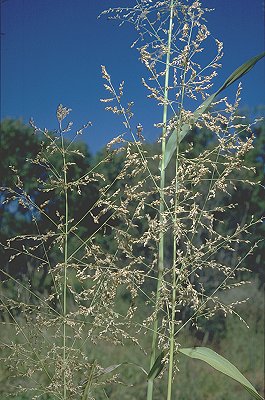 |
 |
|
 |
 |
|

Panicum antidotale Retz.
|
Common name
Blue Panic
Giant Panic
Derivation
Panicum L., Sp. Pl. 55 (1753) & Gen. Pl. 5th edn, 29 (1754);
Panicum: old Latin name for common millet (Setaria italica), from
Latin panis (bread).
antidotale- from the Latin antidotum (antidote) and -ale (pertaining to). Smoke from burning plants used as a disinfectant against smallpox.
Published in
Obs. Bot. 4: 17 (1786).
Habit
Perennial. Rootstock evident. Cataphylls present. Rhizomes short. Stolons absent.
Culms erect or geniculately ascending, 30–200 cm tall, woody, 5–15-noded.
Mid-culm internodes pruinose or glabrous. Mid-culm nodes swollen, glabrous or
pubescent. Lateral branches sparsely branched or branched. Leaf-sheaths outer
margin glabrous. Leaf-sheath auricles absent. Ligule a fringed membrane or a
fringe of hairs. Leaf-blades 6–30 cm long, 2.5–15 mm wide. Leaf-blade
midrib conspicuous. Leaf-blade surface smooth. Leaf-blade apex attenuate.
Inflorescence
Inflorescence compound, a panicle, exserted. Panicle open, oblong or ovate or
pyramidal, 13–32 cm long, contracted about primary branches. Primary panicle
branches spreading, not whorled or whorled at most nodes, 5–15 cm long.
Spikelets
Spikelets solitary. Pedicels 0.5–2 mm long, scaberulous. Fertile spikelets
2-flowered, comprising 1 fertile floret, lower floret male, upper fertile, without
rhachilla extension, elliptic or ovate, dorsally compressed, acute, 2.4–3.2
mm long, falling entire. Rhachilla internodes brief up to lowest fertile floret.
Glumes
Glumes thinner than fertile lemma. Lower glume ovate, not gibbous, 1.3–2
mm long, 50–66% of length of spikelet, membranous, much thinner on
margins, 3–5-nerved. Lower glume apex acute, muticous. Upper glume ovate,
2.5–3.2 mm long, 100% of length of spikelet, membranous, with hyaline
margins, 7–9-nerved. Upper glume apex acute.
Florets
Basal sterile floret 1, with palea. Lemma of lower sterile floret similar to
upper glume, ovate, 2.5–3.2 mm long, 100% of length of spikelet, membranous,
7–9-nerved, acute, mucronate. Palea of lower sterile floret 100% of
length of lemma. Fertile lemma oblong, dorsally compressed, 1.5–2.6 mm
long, indurate, pallid or yellow, glossy. Lemma surface smooth. Lemma margins
involute. Lemma apex acute, muticous or mucronate. Palea involute, indurate.
Anthers 3, 1–2 mm long. Grain with adherent pericarp, oblong or ovoid,
0.25 mm long.
Continental Distribution:
Africa, Temperate Asia, Tropical Asia, Australasia, Pacific, North America,
South America.
Australian Distribution:
Western Australia, Northern Territory, South Australia, Queensland, New South
Wales.
Western Australia: Gardner, Fitzgerald, Irwin, Drummond, Avon. Northern Territory: Darwin & Gulf, Central Australia North, Central Australia South. South Australia: Murray.Queensland: South Kennedy, Port Curtis, Leichhardt, Burnett, Darling Downs, Moreton, Mitchell, Warrego, Maranoa. New South Wales: North Coast, Central Coast, Northern Tablelands, North-Western Slopes, Central-Western Slopes, North-Western Plains, South-Western Plains.
Classification. (GPWG
2001):
Panicoideae, Paniceae
Notes
Introduced. Native to India but now widely introduced as a forage species or
for soil binding. Flowers essentially throughout the year.

Inflorescence (photo)
© D. Albrecht